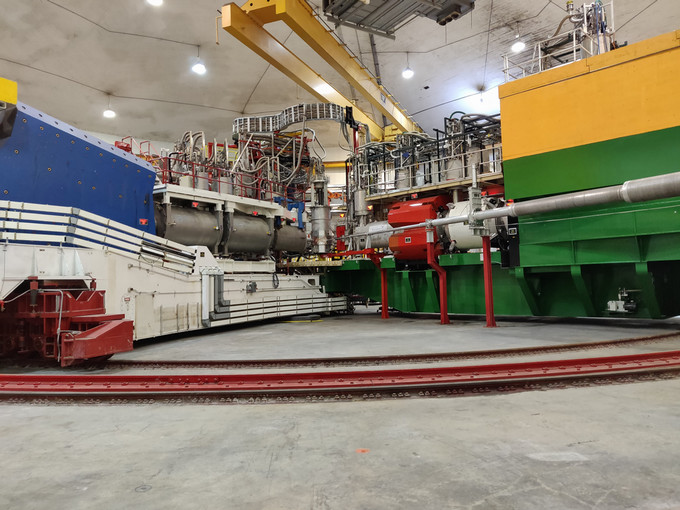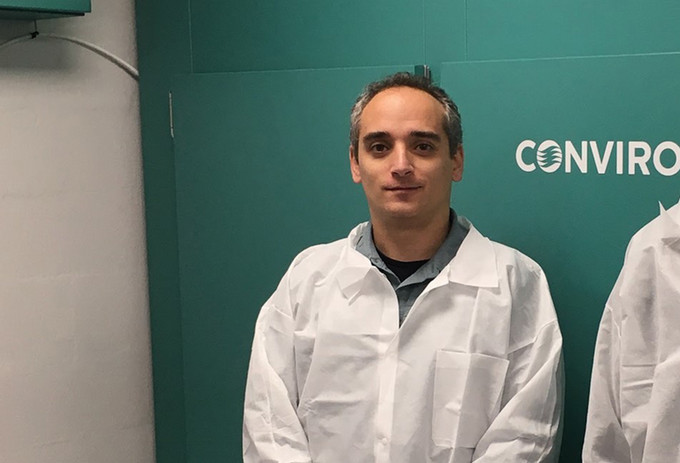
Hadronic QCD
Our Research Explained for the Public
The aim of our research group is to study and understand certain aspects of the inner workings of the fundamental building blocks of matter (quarks) and their "mortar" (gluons). Quarks are not manifested as free particles in nature, therefore their study involves investigations of their stable combinations in particles, such as nucleons (protons and neutrons) as well as the particles which "transmit" the nuclear force among them, the mesons. Ultimately, the glue itself, which binds quarks, is also an objective of our investigations.
In order to accomplish these goals, our group leads experimental efforts in the field of subatomic physics. To that end, we are mapping out the structure of conventional mesons accurately, in order to test theoretical predictions and to provide valuable input to the interpretation of other experiments in the field. Additionally, the nature of the interaction among quarks is best investigated with photons (quanta of pure energy) through the production of exotic mesons which are not found in ordinary matter. Our experiments are being carried out at the high energy electron beam at the Jefferson Lab (USA), because electrons do not have a composite structure of their own and are thus the cleanest probe to access the desired physics, and will be extended at a future facility called the Electron-Ion Collider.
Technical Details
For the past quarter-century, physicists have suspected that subatomic particles made of the very glue that holds matter together at the most fundamental level must exist. Recently, searches for these elusive particles have intensified as tantalizing hints of their presence have appeared. These include evidence for exotics (mesons with exotic quantum number combinations). The GlueX project at Jefferson Lab aims to identify these unusual particles predicted by QCD, but whose structure lies outside the quark model. The JLab Eta Factory (JEF) experiment will involve precision measurements of eta rare de-cays, using an upgraded FCAL calorimeter. The eta decay photons and leptons will be measured with a high- granularity, high-resolution PbWO4 crystal core in the central FCAL-II region, which minimizes shower overlaps and optimizes the energy and position resolutions. Access to eta decays provides a rich flavor-conserving laboratory for new physics beyond the Standard Model (SM): JEF will facilitate the search for gauge boson candidates in the sub-GeV mass range, probing highly motivated portals coupling the SM to the dark sector. JEF will also test fundamental symmetries and the quark mass ratio, among others.
- We are a leading group in the GlueX Project.
- We have co-spokespersonship in the JEF Experiment.
The Standard Model of particle physics now lies at the center of much nuclear physics research. It is widely accepted that nucleons and nuclei are built from quarks, and the theory which describes their behavior is Quantum ChromoDynamics (QCD), but the nature of the strong force at long distances, where quark confinement dominates, remains one of the major unsolved problems of modern physics.
Central to the problem of the transition of QCD from long to short distance scales is the pion, which has a particularly important role in nature. As the lightest meson, with a single valence quark and a single valence anti-quark, it is responsible for the long range character of the strong interaction that binds the atomic nucleus. The pion is seen as key to confirm the mechanisms that dynamically generate >90% of the mass of the visible universe and central to the effort to understand hadron structure. With such strong theoretical motivation, it is vital to the study the pion electric form factor, which encodes our knowledge of the distribution of quarks and gluons within it. The kaon form factor, where the d anti-quark is replaced with an s anti-quark, provides a vital second QCD study case.
- We lead several studies of Deep Exclusive Meson Production at Hall C of JLab
- We have co-spokespersonship in the Pion and Kaon Form Factor programs at Jefferson Lab.
The Solenoidal Large Intensity Device (SoLID) is a new experimental apparatus planned for Jefferson Lab. SoLID will combine large angular and momentum acceptance with the capability to handle very high data rates at high luminosity. With a slate of approved high-impact physics experiments, SoLID will push JLab to a new limit at the QCD intensity frontier that will exploit the full potential of its 12 GeV electron beam.
- More information about SoLID
- We have recently received funding to help construct a Cherenkov detector for SoLID
The Electron-Ion Collider (EIC) is a premier project in nuclear physics, under design and soon construction with plans of it coming online in the early 2030s. It aims to study the dynamic interactions of the smallest internal building blocks of visible matter, quarks and gluons, and help us understand the underlying laws that govern the strongest force in nature. We are part of EIC Canada. We have undertaken a central role in the design and construction of the Barrel Imaging Calorimeter (BIC) together with groups in the USA, Germany and Korea.
- We play a leading role in the Electron-Ion Collider
- Learn more about the collaboration here and here
- We are also doing feasibility studies of future meson structure experiements with the EIC


